- Home
- J. M. Barrie
The Annotated Peter Pan (The Centennial Edition) (The Annotated Books)
The Annotated Peter Pan (The Centennial Edition) (The Annotated Books) Read online
To the Five:
For Lauren and Daniel,
as always,
and for the boys in the next generation,
Ben, Sam, and Grant
Contents
A Message for Those Who Have Grown Up
A Note from the Author about Peter Pan and J. M. Barrie
Introduction to J. M. Barrie’s Peter Pan
J. M. Barrie in Neverland: A Biographical Essay
PETER AND WENDY by J. M. Barrie
CHAPTER 1: Peter Breaks Through
CHAPTER 2: The Shadow
CHAPTER 3: Come Away, Come Away!
CHAPTER 4: The Flight
CHAPTER 5: The Island Come True
CHAPTER 6: The Little House
CHAPTER 7: The Home under the Ground
CHAPTER 8: The Mermaids’ Lagoon
CHAPTER 9: The Never Bird
CHAPTER 10: The Happy Home
CHAPTER 11: Wendy’s Story
CHAPTER 12: The Children Are Carried Off
CHAPTER 13: Do You Believe in Fairies?
CHAPTER 14: The Pirate Ship
CHAPTER 15: “Hook or Me This Time”
CHAPTER 16: The Return Home
CHAPTER 17: When Wendy Grew Up
J. M. Barrie’s The Boy Castaways of Black Lake Island
“To the Five, a Dedication”: J. M. Barrie’s Introduction to the Play Peter Pan
Arthur Rackham and Peter Pan in Kensington Gardens: A Biography of the Artist
An Introduction to Arthur Rackham’s Illustrations for Peter Pan in Kensington Gardens
Arthur Rackham’s Illustrations for Peter Pan in Kensington Gardens
J. M. Barrie’s Scenario for a Proposed Film of Peter Pan
Peter Pan On-Screen: A Cinematic Survey
Peter Pan: Adaptations, Prequels, Sequels, and Spin-Offs
A Montage of Friends, Fans, and Foes: J. M. Barrie and Peter Pan in the World
J. M. Barrie’s Legacy: Peter Pan and Great Ormond Street Hospital for Children by Christine De Poortere
Bibliography
Acknowledgments
A Message for Those Who Have Grown Up
All children, except one, grow up,” J. M. Barrie tells us, in the famous first sentence of his novel Peter and Wendy, published seven years after Peter Pan’s theatrical debut in London. That one rebellious child exists in many different versions today. There is Walt Disney’s redheaded Peter Pan, animated in both senses of the term. There are the many nimble women of Broadway—Mary Martin, Sandy Duncan, and Cathy Rigby—who have soared across the stage as Peter Pan. There is the enchanting Peter Pan who magically appears at the home of the Llewelyn Davies boys, when their mother is ill, in Marc Forster’s Finding Neverland. We encounter the boy who would not grow up on stage and screen, and also in fiction, with countless prequels, sequels, adaptations, and revisions. Peter Pan may refuse to grow up, but he also will not die.
When I rediscovered Peter Pan as an adult, I quickly learned that he existed in multiple textual forms even before he detached himself, to lead a life of his own, from the Scottish writer who dreamt him up. He was first brought to life in Barrie’s 1902 novel The Little White Bird, a whimsical and elusive work (Barrie hated both those adjectives, in part because they captured his style so perfectly) about a bachelor who develops an attachment to a six-year-old boy named David. Embedded in that novel is the story of a seven-day-old Peter Pan and his adventures in Kensington Gardens (“All perambulators lead to the Kensington Gardens”). The chapters about Peter Pan were published separately in 1906, with only a few minor changes, under the title Peter Pan in Kensington Gardens. The volume was illustrated by the artist Arthur Rackham, perhaps the most acclaimed children’s book illustrator of his day, best known today for images he created for fairy tales by the Brothers Grimm and by Hans Christian Andersen and for works ranging from Aesop’s Fables to Kenneth Grahame’s The Wind in the Willows.
Today, we know Peter Pan best in his role as lead of the 1904 play Peter Pan, or The Boy Who Wouldn’t Grow Up. The play did not appear in print until 1928, but in 1911 Barrie published the novel Peter and Wendy, which became known as Peter Pan. To recapitulate, we have:
Program for the London production of Peter Pan. (Beinecke Rare Book and Manuscript Library, Yale University)
The Little White Bird, 1902
Peter Pan, or The Boy Who Wouldn’t Grow Up (stage premiere) 1904
Peter Pan in Kensington Gardens, illustrated by Arthur Rackham, 1906
Peter and Wendy, 1911 (later renamed Peter Pan)
Peter Pan, or, The Boy Who Would Not Grow Up, published in 1928
The play, which existed only in performance for many years, underwent multiple revisions. Barrie attended rehearsals and was constantly cutting, revising, and adding new material, collaborating with the actors and actresses to improve dialogue and staging. Many of the early scripts are preserved in the J. M. Barrie archive at the Beinecke Rare Book and Manuscript Library in New Haven, Connecticut, where the bulk of Barrie’s papers are stored. To give one example: on onion-skin sheets in a small folder marked 1904/05, the third act of what was then a three-act play showed Wendy agreeing to become Peter’s mother and to live with him in Kensington Gardens. The two discover a baby under some rubbish in the park, and a delighted Wendy, who realizes that Peter will need someone to take care of him once she grows up, takes the child in. The curtain falls on Peter, Wendy, and child as they wave from their perch in Kensington Gardens. Who knew that there were also performances in which anywhere from a dozen to twenty beautiful mothers compete with one another to adopt one of the lost boys? Or that Hook survived the crocodile attack on the high seas in an early version of the play but accidentally lowered himself into its gaping jaw while climbing down a tree in Kensington Gardens?
Postcard of Cecilia Loftus and Hilda Trevelyan in Peter Pan. (Beinecke Rare Book and Manuscript Library, Yale University)
The conventional story of a Peter Pan who enters the nursery of the Darling family, abducts the children by teaching them how to fly, and escorts them with Tinker Bell to Neverland is far less stable than most of us realize. To be sure, in all versions the children and the lost boys on the island still come into conflict with pirates and “redskins,” and Peter must always battle the wicked Captain Hook. But the return home is imagined in a variety of ways, and we do not always have a grown-up Wendy at the end of the play, with a daughter who will fly off to Neverland to help Peter with his spring cleaning. For Barrie, Peter Pan existed in performance, and the various typescripts reveal exactly how much he loved to see the character come alive onstage and transform and renew himself with each new production.
A scene from the first production of Peter Pan, showing the beautiful mothers and the boys they are hoping to adopt. (Courtesy of Great Ormond Street Hospital Children’s Charity)
Barrie at first refused to fix his iconic character in print. “Mr. Barrie has often been asked to write a short narrative or libretto of his immortal child’s play and has as often refused,” the Bookman reported in 1907.1 Barrie may have stalled, but others were quick to supply keepsakes, alphabets, and picture books. Daniel S. O’Connor’s Peter Pan Keepsake appeared just in time to satisfy the desires of young theatergoers, who wanted a print version of the story. It was followed in the same year by The Peter Pan Picture Book, also by O’Connor, with illustrations by Alice B. Woodward. Oliver Herford published a charming Peter Pan Alphabet in 1909, and G. D. Drennan fleshed out the story with his Peter Pan: His Book, His Pictures, His Career, His Friends.
G.
D. Drennan capitalized on the growing popularity of Peter Pan with a 1909 volume that promised to elaborate on what was in the play. (Beinecke Rare Book and Manuscript Library, Yale University)
Barrie finally gave in to requests for an official story, with a narrative entitled Peter and Wendy, published in 1911 and illustrated by F. D. Bedford (a gallery of those illustrations is included in this volume). Like Peter Pan himself, that novel is betwixt and between, forever shifting its orientation from children to adults and then back again. Readers today will not be surprised to learn that it was constantly reshaped, adapted, and rewritten in Barrie’s own day, although mainly by writers authorized by Barrie to recast the story for “little people” or for “boys and girls.” Still that version of the story is one that captures, crystallizes, and broadens what Barrie wanted to say with the figure of Peter Pan, and for that reason, I use it as the text for this annotated volume. Since it came to be published under the title Peter Pan, I have kept that appellation in the title for this volume, although I will differentiate (when necessary) between play and novel by referring to one as Peter Pan and the other as Peter and Wendy. Nearly all my annotations are relevant to the play as well, which exists in many print versions. Peter Hollindale offers an excellent introduction to the stage version in his J. M. Barrie: Peter Pan and Other Plays.
Advertisement for a miniature Peter Pan theater for children and for Peter Pan Crackers. (Beinecke Rare Book and Manuscript Library, Yale University)
This volume aims to keep readers under the spell even as they learn more about Peter and Wendy and its author. Some will appreciate a dose of reality with their Peter and Wendy, while others may prefer to avoid the annotations and focus on Barrie’s story alone and the illustrations that offer visual points of entry into it. My own years spent with J. M. Barrie and Peter Pan continue to expand my appreciation and understanding of a work that will not grow old and that becomes more magical with each new reading. The story behind Peter Pan is as moving as the novel and play itself, and readers will find in this volume two separate essays: an introduction to the novel annotated here and a second to its author. They will discover in the annotations both cultural context and critical response. And in “A Montage of Friends, Fans, and Foes: J. M. Barrie and Peter Pan in the World,” they will learn how readers and audiences have responded to the author and to Peter Pan. Here’s to that magic and its power to move us, transport us, and transform us with energy so radiant that we can experience, even as adults, the “ecstasies innumerable” of Neverland.
Sir George James Frampton, Peter Pan, 1912. Bronze statue in Kensington Gardens, London. (Courtesy of the Bridgeman Art Library)
1. The Bookman, January 1907, 161.
A Note from the Author about Peter Pan and J. M. Barrie
My first memory of Peter Pan goes back to a burst of color that entered my life when I was young. A school chum had invited me to view the musical Peter Pan (with the famed American singer and actress Mary Martin in the lead role) on her grandmother’s brand-new color television set. The apparatus was hopelessly clunky by today’s standards, but we watched the show breathlessly, with a sense of excitement and revelation. Never mind that static interrupted the performance from time to time or that the tiny screen failed to capture the vibrancy and depth of the theatrical set. Like generations of children before me, in London’s Duke of York’s Theatre or New York’s Empire Theatre (where Peter Pan won fame and acclaim), I lost my heart to the boy who would not grow up. For weeks after that, I dreamed about fairy dust and flying.
Michael Llewelyn Davies as Peter Pan, 1906. (Courtesy of Great Ormond Street Hospital Children’s Charity)
Years later, as an adult, I was smitten once again. This time the encounter took place in London’s Kensington Gardens, where I found myself one crisp autumn day, giddy with anticipation at the thought of visiting the celebrated statue of Peter Pan in that park. A map of the city was at hand, but it had not occurred to me that I might need something additional to guide my steps through a public park. After all, I had seen many pictures of the statue and knew something about its general location. The work was cast in bronze and showed Peter, planted on a solid hillock, holding a pipe to his lips to play a tune for an enchanted audience of rabbits, squirrels, mice, and fairies. And I had read that it was situated in a “green glade” about halfway down the west bank of the Long Water (the place where Peter Pan lands after flying out of the nursery).
I had also read up on the statue’s history. Plans for it had developed over a century ago, in 1906, when J. M. Barrie took photographs of a six-year-old boy named Michael Llewelyn Davies in a Peter Pan costume. Six years later Barrie, who had by then become the adoptive father to the boy and his four brothers, commissioned Sir George Frampton, a renowned British sculptor, to make a statue of Peter Pan, based on those photographs of Michael. Frampton ended up using two other boys as models, and Barrie worried forever after that the sculptor had failed to capture any resemblance at all to Michael—“It doesn’t show the Devil in Peter.”1
Despite Barrie’s reservations, the statue of Peter Pan, blowing on his pipe, appeared “like magic” in Kensington Gardens on the morning of May 1, 1912.2 That same day, James Barrie had placed this announcement in the Times:
There is a surprise in store for the children who go to Kensington Gardens to feed the ducks in the Serpentine this morning. Down by the little bay on the south-western side of the tail of the Serpentine they will find a May-day gift by Mr. J. M. Barrie, a figure of Peter Pan blowing his pipe on the stump of a tree, with fairies and mice and squirrels all around. It is the work of Sir George Frampton, and the bronze figure of the boy who would never grow up is delightfully conceived.3
Knowing that Kensington Gardens was not a vast space and feeling the desire to prolong the joyful anticipation of seeing the statue, I meandered through the park, imagining how Frampton had installed the statue under the cover of darkness and wondering whether Barrie had been present that evening. I soon began encountering flocks of single-minded tourists, maps in hand. As they wound their way through the park, most skipped gleefully ahead of me, disappearing around a bend and dissolving into nothing but a collection of symphonic sounds and mellifluous voices. And then suddenly I heard it: a whispered chorus of voices in uncanny unison, uttering the words “Peter Pan” with hushed, barely contained excitement. Even before the statue came into view, I recognized that I was in the presence of something massive, even monumental. We all hailed from different corners of the earth, and yet, in Kensington Gardens, we were, mirabile dictu, also all turned into dazzled pilgrims, reverently united by our faith in fairies and our love for Peter Pan.
New Zealand postage stamp with an image of the Peter Pan statue in Kensington Gardens. (Beinecke Rare Book and Manuscript Library, Yale University)
Those breathless tourists reminded me of Peter Pan’s international appeal. We encounter him, after all, not only in J. M. Barrie’s stagecraft and fiction but also at the movies, when he comes to be refashioned by Walt Disney Studios as an animated figure or by Steven Spielberg as a grown-up lawyer specializing in corporate takeovers. Peter Pan greets us from the label of peanut butter jars and winks at us from the sides of buses making runs from Boston to New York.4 We discover his darker side when we view images of Michael Jackson and his Neverland Valley Ranch, with its eerily life-size figures of Pan, Hook, and other Barrie characters. It was Michael Jackson who famously claimed, in an interview with Martin Bashir, that he was Peter Pan, in his heart, and that he would never grow up.
Signed animation cell from Walt Disney’s Peter Pan, 1952. (Beinecke Rare Book and Manuscript Library, Yale University)
Peter Pan may appear to have been appropriated by corporate culture, but his image and likeness are still protected by Great Ormond Street Hospital for Children, to which J. M. Barrie willed the rights to the play and to the novel Peter and Wendy. (The House of Lords amended the Copyright, Designs and Patent Act in 1988 to extend the expired rights.) I
t goes without saying that he also belongs to everyone—child or adult—who has read his story or watched him onstage. And, as my experience in Kensington Gardens reminded me, their numbers are legion.
Mercurial and flighty, Peter Pan has imprinted himself on each of us in different ways. For that reason, it seemed important to include in this volume my own history with Peter Pan and, more importantly, the story of what felt like a close, personal encounter with J. M. Barrie. It did not take place in Kirriemuir, Scotland, where J. M. Barrie was born, nor in Edinburgh, where he studied, nor in London, which he set out to conquer as a talented young journalist. Instead it took place in the United States, which Barrie had visited on an impulse in 1914, with the hope of raising support for the war effort.
New Haven, Connecticut, seems an unlikely location to meet J. M. Barrie, but it was there that I found him, a living, breathing, spectral presence in the vast archive of papers and memorabilia housed in the Beinecke Library under the heading “MS VAULT BARRIE.” “Nineteen linear feet of documents”: that was how the collection had been described to me. Eager as I was to see those materials, I also shuddered inwardly at the thought of the musty typescripts, letters, and notebooks that awaited me. I also knew that I could not write The Annotated Peter Pan without studying what was at the Beinecke, even though I arrived there having read everything I could track down in print by Barrie or about him.
The Beinecke Library offers generous fellowships that enable scholars with projects pertaining to their collections to spend a month in residence. When I received the good news that there was interest in my project, I mentally divided the nineteen linear feet by the number of days in October and quickly realized that I had only about a day for each foot of documents (the library closes on Saturdays and Sundays). I would have to work quickly and efficiently if I wanted to see everything. And there were also the Llewelyn Davies Family papers, a collection of letters, diaries, and memorabilia left behind by the five boys adopted by J. M. Barrie after the death of both their parents.

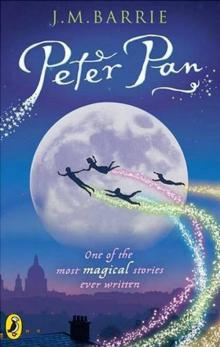 Peter Pan
Peter Pan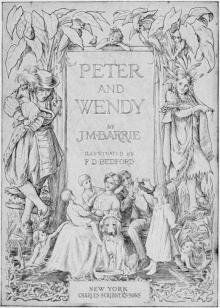 Peter and Wendy
Peter and Wendy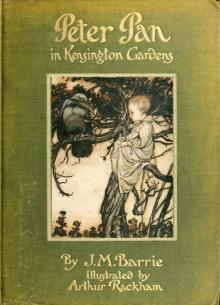 Peter Pan in Kensington Gardens
Peter Pan in Kensington Gardens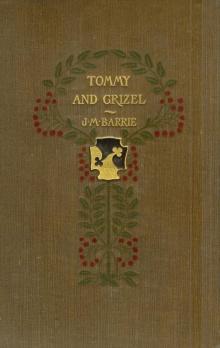 Tommy and Grizel
Tommy and Grizel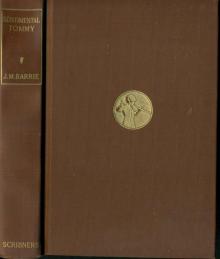 Sentimental Tommy
Sentimental Tommy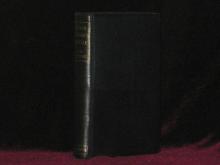 When a Man's Single: A Tale of Literary Life
When a Man's Single: A Tale of Literary Life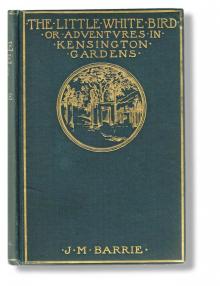 The Little White Bird; Or, Adventures in Kensington Gardens
The Little White Bird; Or, Adventures in Kensington Gardens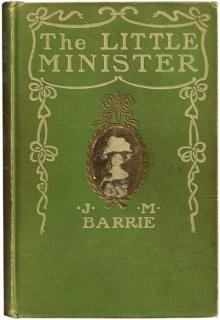 The Little Minister
The Little Minister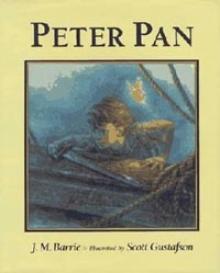 Peter Pan (peter pan)
Peter Pan (peter pan)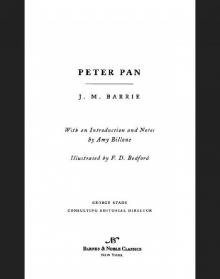 Peter Pan (Barnes & Noble Classics Series)
Peter Pan (Barnes & Noble Classics Series)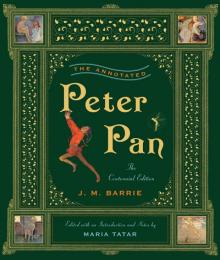 The Annotated Peter Pan (The Centennial Edition) (The Annotated Books)
The Annotated Peter Pan (The Centennial Edition) (The Annotated Books)